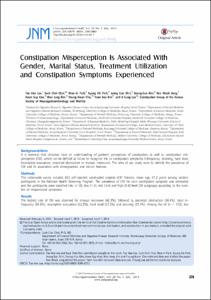KUMEL Repository
1. Journal Papers (연구논문)
1. School of Medicine (의과대학)
Dept. of Internal Medicine (내과학)
Constipation Misperception Is Associated With Gender, Marital Status, Treatment Utilization and Constipation Symptoms Experienced
- Keimyung Author(s)
- Park, Kyung Sik
- Department
- Dept. of Internal Medicine (내과학)
- Journal Title
- Journal of Neurogastroenterology and Motility
- Issued Date
- 2014
- Volume
- 20
- Issue
- 3
- Keyword
- Constipation; Health surveys; Perception
- Abstract
- Background/Aims:
It is essential that clinicians have an understanding of patients’ perceptions of constipation as well as constipation mis-perception (CM), which can be defined as failure to recognize the six constipation symptoms (infrequency, straining, hard stool, incomplete evacuation, anorectal obstruction or manual maneuver). The aims of our study were to identify the prevalence of CM and its association with demographics and clinical features.
Methods:
This nationwide survey included 625 self-reported constipated subjects (431 females; mean age, 41.2 years) among random participants in the National Health Screening Program. The prevalence of CM for each constipation symptom was estimated, and the participants were classified into nil (0), low (1?2), mid (3?4) and high (5?6) level CM subgroups according to the number of misperceived symptoms.
Results:
The highest rate of CM was observed for manual maneuver (48.3%), followed by anorectal obstruction (38.4%), stool infrequency (34.6%), incomplete evacuation (32.2%), hard stool (27.2%) and straining (25.4%). Among the nil (n = 153), low (n = 242), mid (n = 144) and high level (n = 86) subgroups, there were significant differences in the proportions of males (18.3%, 34.3%, 39.6% and 30.2%; P = 0.001, respectively), never-married status (25.7%, 38.2%, 36.8% and 45.9%; P = 0.030, respectively) and those who did not receive treatment for constipation (41.8%, 47.5%, 58.3% and 66.3%; P < 0.001, respectively). There was a significant linear trend of increasing degree of CM with decreasing symptoms experienced (P < 0.001).
Conclusions:
CM is significantly associated with gender, marital status, treatment utilization and the range of constipation symptoms experienced.
- Keimyung Author(s)(Kor)
- 박경식
- Publisher
- School of Medicine
- Citation
- Tae Hee Lee et al. (2014). Constipation Misperception Is Associated With Gender, Marital Status, Treatment Utilization and Constipation Symptoms Experienced. Journal of Neurogastroenterology and Motility, 20(3), 379–387. doi: 10.5056/jnm14011
- Type
- Article
- ISSN
- 2093-0879
- DOI
- 10.5056/jnm14011
- Appears in Collections:
- 1. School of Medicine (의과대학) > Dept. of Internal Medicine (내과학)
- 파일 목록
-
-
Download
 oak-aaa-2496.pdf
기타 데이터 / 471.81 kB / Adobe PDF
oak-aaa-2496.pdf
기타 데이터 / 471.81 kB / Adobe PDF
-
Items in Repository are protected by copyright, with all rights reserved, unless otherwise indicated.